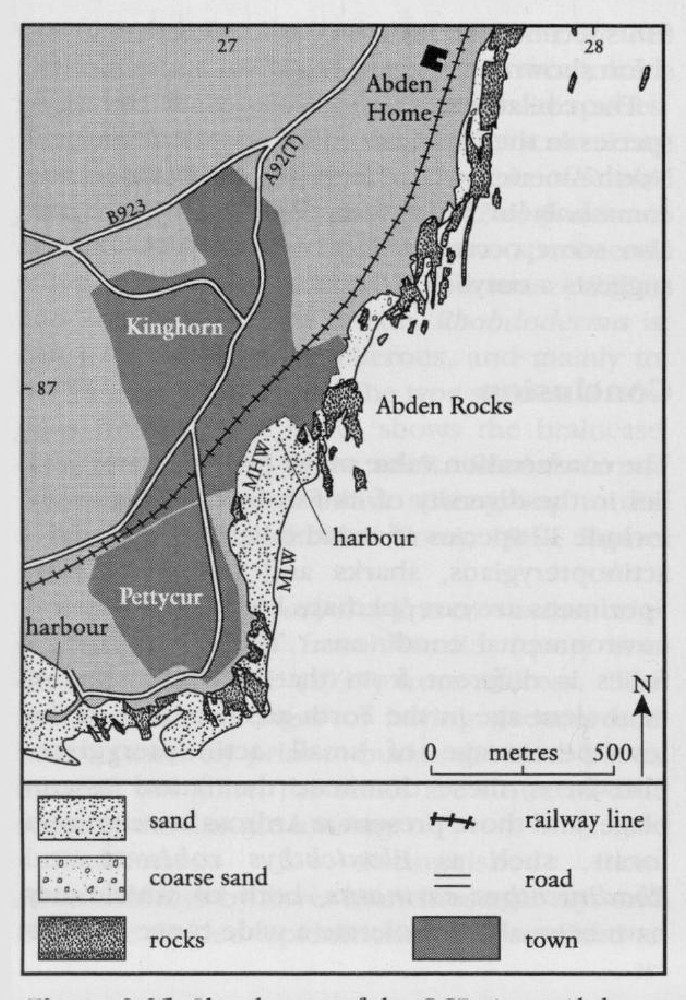Abden
Highlights
The fish fauna from Abden near Kirkcaldy in Fife is one of the youngest from the Scottish Early Carboniferous, and it is the source of about nine species, including the original material of one species. Sharks are rare, which may indicate a somewhat unusual marine environment.
Introduction
Fossil fishes were originally found at Abden in Victorian times, and they were described first by Traquair (1890c). More recent work on Carboniferous fishes, such as papers by Moy-Thomas (1937c), Patterson (1965) and Forey (1981), has redescribed material from Abden.
Description
The Abden Bone Bed occurs in the Uppermost Calciferous Sandstone Series of the Brigantian (late Viséan) of Fife. Westoll (1951) also included the Blackband Ironstone fauna from Niddrie and the Ardross Shrimp Bed as the 'Abden Fauna'. These rocks crop out on the foreshore north of Abden Rocks, Kinghorn Burgh
Fauna
Acanthodii: Acanthodiiformes: Acanthodidae
Acanthodes sp.
Osteichthyes: Sarcopterygii: (Actinistia)
Diplocercides davisi (Moy-Thomas, 1937) ( = Rhabdoderma(?) abdenense Moy-Thomas, 1937)
Osteichthyes: Actinopterygii: Amphicentridae
Cheirodus crassus Traquair, 1890
Type locality
Eurynotus crenatus Agassiz, 1835
Osteichthyes: Actinopterygii: Acrolepidae
Nematoptychius greenocki (Traquair, 1867)
Chondrichthyes: Holocephali: Menaspidae
Deltoptychius armigerus (Traquair, 1888)
Chondrichthyes: Elasmobranchii: Ctenacanthiformes
Tristichius arcuatus Agassiz, 1837
Interpretation
Traquair (1890c) noted the presence of a coelacanth at Abden, but did not describe it. Moy-Thomas (1937c) named several forms, Rhabdoderma ? davisi from the Carboniferous Limestone of Armagh and R. ? abdenense for Traquair's coelacanth from Abden. These were both based on isolated head bones, and Moy-Thomas (1937c) recognized the similarity between these two species, and with Diplocercides. Forey (1981) also noted the similarity in the ornamentation on the gulars, operculum and cleithrum between these two species and D. kayseri and D. heiligenstockiensis from the Devonian of Germany, and he synonymized the two British species as Diplocerides davisi (Moy-Thomas, 1937c).
A specimen termed cf. Rhabdoderma sp. from Foulden was described by Forey (1981) as having the same style of ridged ornament on the cleithrum as Rhabdoderma ?abdenense and Diplocercides, but it otherwise showed ornament and shape of head bones which relate it to Rhabdoderma. Thus Forey (1981) showed that the ornament pattern must be more general than previously supposed, but he did not, in that paper, remove davisi from the genus Diplocercides.
The actinopterygian Cheirodus has a lozenge-shaped deep body with two marked angles, one on the dorsal side and one in front of the anal fin. The anal and dorsal fins are long-based; there are small pectorals, and although it has been thought that it had no pelvic fins (e.g. Lehman, 1966), material from Bearsden (q.v.) shows their presence. Cheirodus is known from the Carboniferous of England, Scotland and the USA (Lehman, 1966). Gardiner and Schaeffer (1989) place the genus in their Platysomus terminal group. The original description of Cheirodus crassus Traquair, 1890 was based on seven isolated scales from Abden (Traquair, 1890c), which have coarse ornament. Some scales also occur at Beith, associated with den-tary plates (Traquair, 1890c). White (1937) redescribed the species on the basis of an almost complete specimen from Ardross Castle (q.v.).
Patterson (1965) figured two examples of holocephalan mandibular spines from Abden, as part of a series to illustrate the variation in their style of shape and ornamentation. These may be termed Deltoptychius armigerus.
The particular faunal assemblage from Abden was referred to as the Abden Fauna' by Westoll (1951). He regarded it as different from the more typical 'Marine Fauna' of, for example the
Conclusion
Abden produced some good fish specimens in the late 19th and early 20th centuries, hence its conservation value. The fauna differs from that of other localities of similar age in the rarity of sharks. Further collecting of fish specimens, and study of the sedimentology, may demonstrate whether these faunal differences truly reflect an unusual environment of marine deposition.

